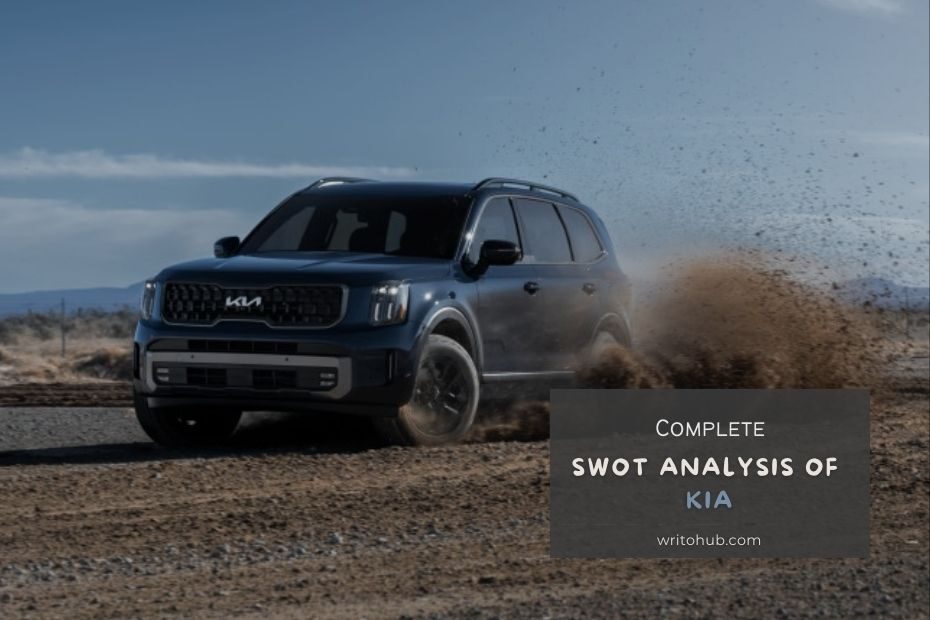The SWOT Analysis of Kia tells the SWOT (Strengths, Weaknesses, Opportunities, and Threats) of the South Korean multinational automobile manufacturer – Kia!
Kia Corporation, an automotive company, has gained prominence in the global automotive market.
A comprehensive SWOT analysis of Kia reveals its strengths, weaknesses, opportunities, and threats, providing insights into its strategic position in the dynamic automotive industry.
Strengths in the SWOT Analysis of Kia
- Quality Improvements: Kia has made significant strides in improving product quality and reliability, contributing to enhanced brand perception.
- Stylish Design: The brand is known for its modern and eye-catching vehicle designs, attracting style-conscious consumers.
- Global Presence: Kia operates in numerous countries, with manufacturing plants in key regions, facilitating access to diverse markets.
- Hybrid and Electric Vehicles: Kia offers a range of hybrid and electric vehicles, like the Kia Niro and Soul EV, aligning with the shift toward sustainable mobility.
- Value for Money: Kia is perceived as offering good value for money, appealing to cost-conscious consumers.
Weaknesses in the SWOT Analysis of Kia
- Brand Perception: While improving, Kia still faces the perception of being a budget brand, which can affect pricing power.
- Dependence on Some Markets: Kia’s revenue heavily depends on specific markets, making it vulnerable to regional economic fluctuations.
- Limited Luxury Segment Presence: Kia has a limited presence in the luxury vehicle segment compared to some competitors.
- Competition: The automotive industry is highly competitive, with many established automakers and new entrants vying for market share.
- Economic Volatility: Economic downturns can impact vehicle sales as consumer spending on discretionary items decreases.
Opportunities in the SWOT Analysis of Kia
- Electric and Autonomous Vehicles: Expanding the electric vehicle lineup and advancing autonomous driving technology can position Kia as a leader in future mobility.
- Global Expansion: Exploring emerging markets and increasing presence in regions with growing demand for vehicles can boost sales.
- Digital Transformation: Enhancing digital connectivity, infotainment systems, and AI-driven features can attract tech-savvy consumers.
- Sustainability Initiatives: Focusing on sustainability practices, such as reducing emissions and incorporating renewable materials, aligns with evolving consumer preferences.
- Mobility Services: Venturing into mobility services like ride-sharing and car-sharing can create new revenue streams.
Threats in the SWOT Analysis of Kia
- Intense Competition: Kia faces competition from established automakers, electric vehicle manufacturers, and tech companies entering the automotive sector.
- Regulatory Changes: Evolving emissions regulations and safety standards can impact Kia’s ability to produce vehicles with specific technologies.
- Supply Chain Disruptions: Disruptions in the supply chain, such as semiconductor shortages, can affect production and delivery times.
- Economic Downturns: Economic instability can lead to reduced consumer spending on vehicles, impacting sales.
- Cybersecurity Risks: As vehicles become more connected, the threat of cybersecurity breaches and data privacy concerns could impact customer trust.
Conclusion
Kia’s SWOT analysis underscores its position as a globally recognized automotive manufacturer, leveraging strengths to address weaknesses, seize opportunities, and mitigate threats.
The company’s commitment to innovation, sustainability, and customer value will play a crucial role in determining its continued success in the competitive automotive industry.
